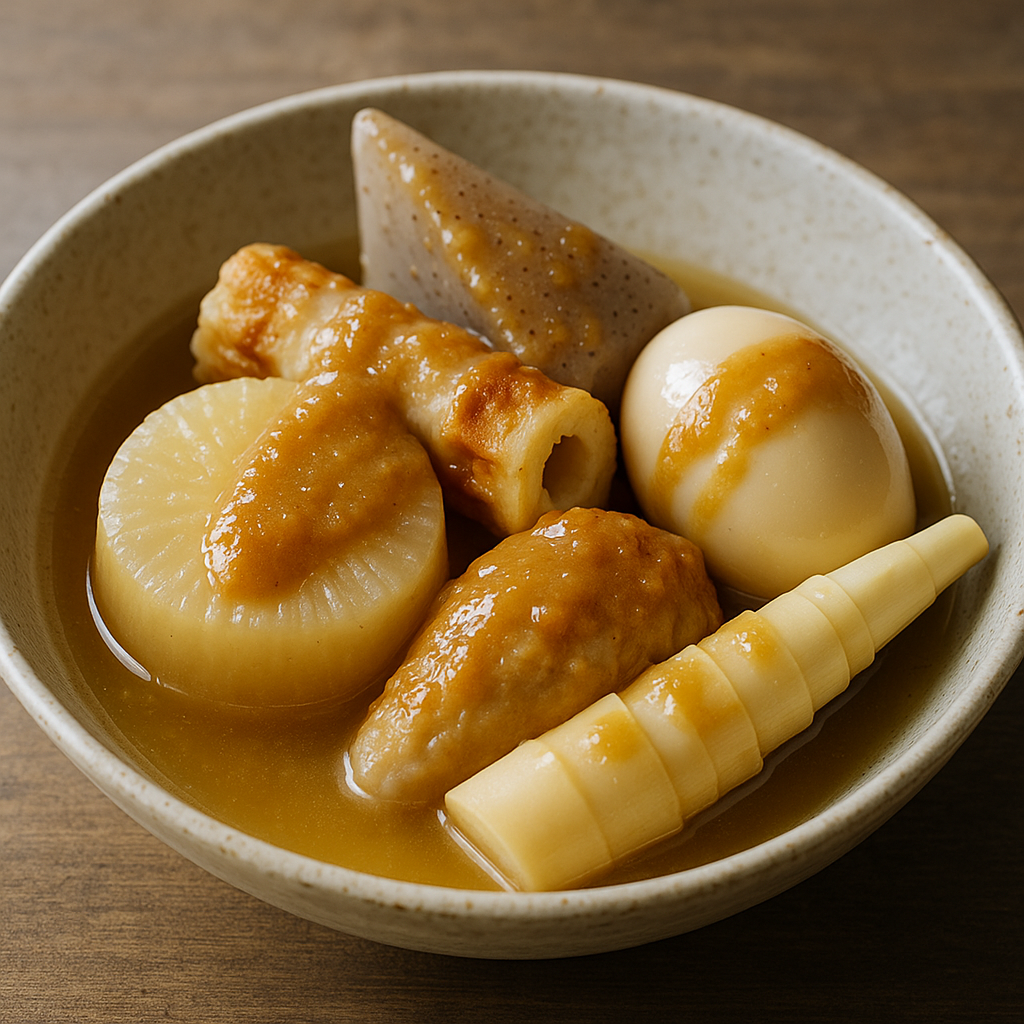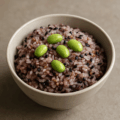しょうが味噌おでんの特徴
青森で親しまれる“追いだれ”スタイル
だしでじっくり煮含めたおでん種に、甘めのしょうが味噌をたっぷり添えて食べるのが青森流。生姜の香りと味噌のコクがだしの旨みを引き立て、寒い季節に体の芯から温まります。
甘辛×生姜のキレで後味すっきり
味噌だれは砂糖・みりんでまろやかにしつつ、すりおろし生姜でキレをプラス。辛子よりも柔らかな辛味で、子どもから年配まで幅広く好まれます。
屋台の味を家庭で
大根・卵・こんにゃく・練り物など定番のおでん種に仕上げにしょうが味噌を添えるだけ。作り置きにも向き、翌日はさらに味がなじみます。
しょうが味噌おでんのレシピ
材料(4人分)
- 大根 … 1/2本(3cm厚の輪切り・面取り・下ゆで)
- 卵 … 4個(ゆで卵)
- こんにゃく … 1枚(格子に切り目→下ゆで)
- ちくわ・さつま揚げ … 合計6〜8個
- 厚揚げ … 1枚(一口大)
- ねまがりたけ…4本
おでんだし
- だし … 1.5L(昆布10cm+かつお節/または市販だしでも可)
- 薄口醤油 … 大さじ3
- みりん … 大さじ2
- 塩 … 小さじ1/2〜
- 酒 … 大さじ2
しょうが味噌だれ(作りやすい量)
- 味噌(赤または合わせ) … 80g
- 砂糖 … 大さじ2
- みりん … 大さじ2
- 酒 … 大さじ1
- だし … 大さじ2(濃度調整)
- 生姜 … 20g(すりおろし/汁ごと)
作り方
- 下ごしらえ:大根は面取りして米のとぎ汁(または米ひとつまみ)で下ゆでし、ぬるま湯で優しく洗う。こんにゃく・白滝は下ゆでして臭みを抜く。卵は殻をむく。
- だしを合わせる:鍋にだし・薄口醤油・みりん・塩・酒を入れ、味を見て整える(やや薄めが基本)。
- 煮含める:大根→こんにゃく→厚揚げ→ねまがりたけ→練り物→卵の順に入れ、弱めの中火で40〜60分静かに煮る。途中アクを取る。火を止めて30分以上置くと味が入る。
- しょうが味噌だれ:小鍋に味噌・砂糖・みりん・酒・だしを入れ、弱火でふつふつとするまで混ぜながら加熱。火を止めてから生姜を加え、よく混ぜる(加熱しすぎると香りが飛ぶ)。
- 仕上げ:温め直したおでんを器に盛り、しょうが味噌を添える。好みで七味少々。
シェフのワンポイントアドバイス
- 大根は下ゆで必須。芯まで透明感が出る直前がベスト。
- だしは“やや薄味”にし、しょうが味噌で味を決めるとバランス良好。
- 一晩置くと味がなじみ、翌日はさらにおいしいです。
- ねまがりたけの代わりにタケノコで代用しても問題ありません。
栄養価(1人分の目安/盛り合わせ)
- エネルギー:約220〜350 kcal(種の内容で変動)
- たんぱく質:12〜20 g
- 脂質:6〜14 g
- 炭水化物:20〜35 g
低脂質でだし中心のヘルシーな一椀。しょうが味噌はかけ過ぎず、少量ずつ足すと塩分をコントロールしやすいです。
歴史
屋台文化が育てた“生姜の一さじ”
冬の屋台や食堂で親しまれたおでんに、体を温める生姜と味噌を合わせて添えるスタイルが広がり、青森を代表する“寒の味”として定着。各家庭・店で味噌の種類や甘さ、生姜の利かせ方に個性が受け継がれています。
English Version
Features of Ginger–Miso Oden (Aomori)
Aomori’s “add-at-the-table” style
In the Aomori style, classic oden ingredients simmered in dashi are served with a generous spoon of sweet ginger–miso on the side. The aroma of fresh ginger and the depth of miso lift the broth’s savor and warm you to the core in winter.
Sweet–savory with a clean ginger finish
The sauce is mellowed with sugar and mirin, then brightened with freshly grated ginger. Softer than mustard heat, it’s widely loved from kids to seniors.
Street-stall comfort at home
Top standard oden pieces—daikon, eggs, konnyaku, fish cakes—with ginger–miso to finish. It keeps well, and tastes even better the next day.
Recipe
Ingredients (serves 4)
- Daikon … 1/2 (3 cm-thick rounds; beveled edges; parboiled)
- Eggs … 4 (hard-boiled, peeled)
- Konnyaku … 1 slab (crosshatched; parboiled)
- Chikuwa & satsuma-age … 6–8 pieces total
- Atsuage (thick fried tofu) … 1 block (bite-size)
- Nemagaritake (young bamboo shoots) … 4 spears
Oden Broth
- Dashi … 1.5 L (kombu 10 cm + katsuobushi; or good store-bought dashi)
- Light soy sauce … 3 tbsp
- Mirin … 2 tbsp
- Salt … 1/2 tsp or to taste
- Sake … 2 tbsp
Ginger–Miso Sauce (small batch)
- Miso (red or blended) … 80 g
- Sugar … 2 tbsp
- Mirin … 2 tbsp
- Sake … 1 tbsp
- Dashi … 2 tbsp (to adjust thickness)
- Fresh ginger … 20 g (finely grated, with juice)
Instructions
- Prep: Bevel the daikon edges and parboil in rice-rinse water (or water with a pinch of uncooked rice); rinse gently in lukewarm water. Parboil konnyaku to remove odor. Peel the eggs.
- Broth: Combine dashi, light soy, mirin, salt, and sake in a pot; season to a light taste.
- Simmer: Add in order—daikon → konnyaku → atsuage → nemagaritake → fish cakes → eggs. Simmer gently over medium-low for 40–60 minutes, skimming as needed. Turn off the heat and let stand 30 minutes or longer to absorb flavor.
- Ginger–miso: In a small saucepan, warm miso, sugar, mirin, sake, and dashi over low heat, stirring until it just bubbles softly. Remove from heat, stir in the grated ginger (overheating dissipates aroma).
- Serve: Rewarm the oden, plate, and spoon on ginger–miso. Add a pinch of shichimi if you like.
Chef’s Tips
- Parboiling daikon is essential; stop when the core turns nearly translucent.
- Keep the broth on the milder side and let the ginger–miso set the final balance.
- Resting overnight deepens flavor for day two.
- No nemagaritake? Substitute regular bamboo shoots without issue.
Nutritional Value (per serving, assortment)
- Calories: ~220–350 kcal (varies by items)
- Protein: 12–20 g
- Fat: 6–14 g
- Carbohydrates: 20–35 g
Light in fat and broth-forward. Add ginger–miso sparingly at first and build up, which also helps manage sodium.
History
From winter stalls to a regional staple
The custom of adding a spoon of warming ginger–miso to oden spread from winter street stalls and eateries, becoming a signature cold-season taste of Aomori. Households and shops vary the miso type, sweetness, and ginger intensity in their own style.



何でも質問してください!